There are 21 species of snakes in Wisconsin. Out of these, there are 2 species of venomous snakes. In this article, we will list the venomous snakes in Wisconsin. We will then describe each snake and tell you where you will likely find them in the state.
First, though, since rattlesnakes are pit vipers, we’re going to talk about snakes in the pit viper family. In the section after that, we’ll talk about rattlesnakes in general.
After those two sections, we’ll talk about each individual snake species. You can skip the first two sections and go directly to the snake you’re interested in. Do this by clicking on its highlighted name.
- Eastern Massasauga – Sistrurus catenatus
- Timber Rattlesnake – Crotalus horridus
Pit Vipers
Both of Wisonsin’s venomous snakes are rattlesnakes. Rattlesnakes belong to the Crotalinae or pit viper family. Another name for these snakes is pit vipers. Pit vipers have pits between their nostrils and eyes. These pits are specialized heat-sensing organs. They use them to detect body heat from prey animals. Pit organs enable pit vipers to strike their prey precisely, even in the dark. They are also able to detect body heat from up to 1 meter away.
Members of the pit viper family also have a large arrowhead-shaped head. It is attached to a comparatively slender neck. Furthermore, they have elliptical pupils that are vertical slits. This is a defining characteristic because a nonvenomous snake generally has round pupils.
Pit vipers have hollow fangs connected to venom glands. They use their fangs to inject venom into their prey. This venom immobilizes the prey, making it easier for the snake to consume. They primarily consume small mammals, reptiles, amphibians, and small birds. These snakes play an important role in maintaining balance in rodent populations.
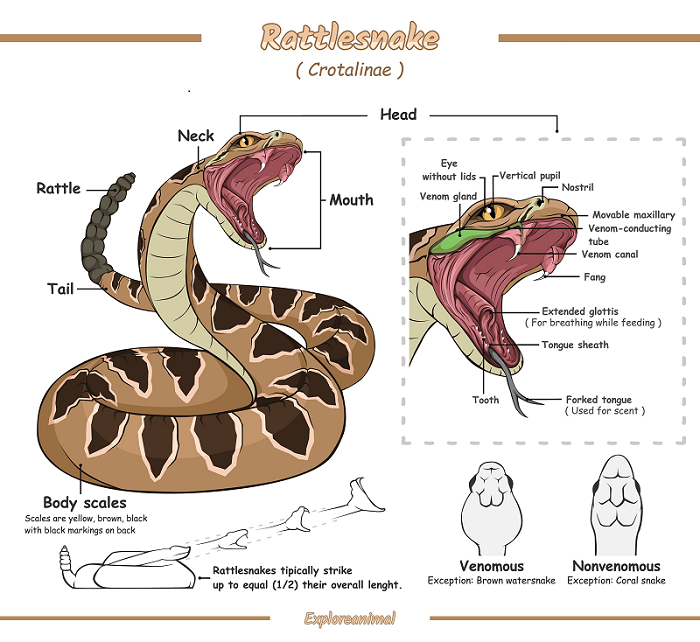
Rattlesnakes
The first thing people think about with regard to rattlesnakes is their tails. When they are disturbed, they vibrate their rattles using their tail muscles. This makes a buzzing or rattling-type sound. The specific purpose of the rattle is to warn larger animals to stay away. Sometimes, rattlers strike without rattling, though. Sometimes, their rattles fall off. Here’s something else to consider. Some Black Hills rattlesnakes have a genetic defect snake experts call curly-q tail. It prevents them from rattling. Source
You must be aware of where you place your hands and feet in rattlesnake country. If you hear a rattling noise, do not move until you spot where it’s coming from. Otherwise, you may accidentally move into the snake, provoking it to strike you. You should carefully move to a safe distance when you’ve located the snake. But carefully scan your surroundings because the snake you see might not be the only one around.
When moving through known rattlesnake habitat, you should have your dog on a leash. If you have hunting dogs, they should be wearing snake armor.
It’s a good idea to carry a long stick. You can use it to tap the ground in front of you to warn any snakes of your approach. You can also use the stick to part any dense vegetation or tall grass in your path.
If you are hiking in rattlesnake country, it would be a good idea to wear snake boots or snake gaiters. This protects your lower legs from being bitten by a snake.
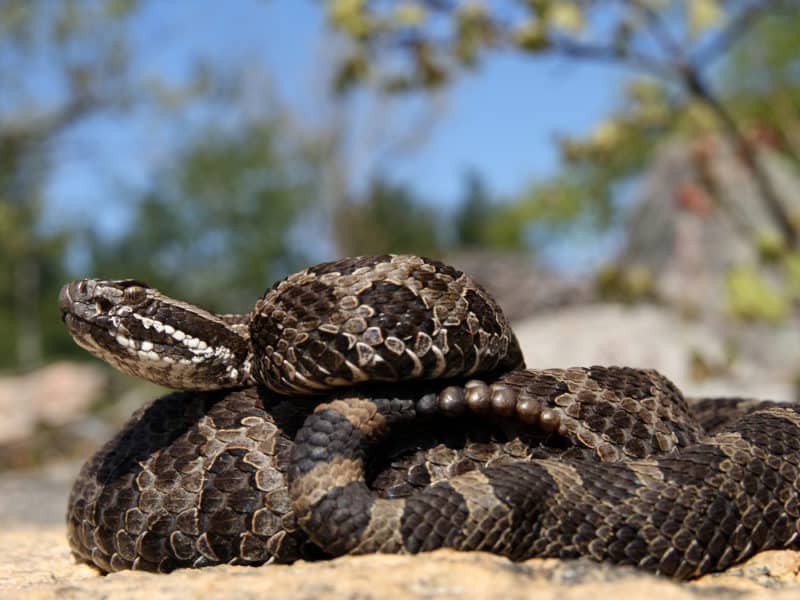
Eastern Massasauga Rattlesnake
| Scientific Name: | Sistrurus catenatus |
| Description: | Adult Eastern Massasaugas average 22 to 30 inches (55 to 75cm) long. Their body is light grey with dark brown blotches. |
| Habitat: | Wet habitats such as swamps or marshy areas near lakes or streams. |
| Conservation Status: | Endangered in Wisconsin |
Eastern Massasaugas are small venomous snakes that are sometimes called swamp rattlers. They are one of two rattlesnake species native to the Great Lakes states. The other is the Timber Rattlesnake.
An adult Massasauga rattlesnake grows to a length between 22 to 30 inches (55 to 75cm). Some individuals may exceed this length.
Their body is a light gray with dark blotches along the spine and along the sides. They also have a dark stripe on each side of their face and across their eye and a white stripe on their heads. Some melanistic snakes are almost entirely black in color.
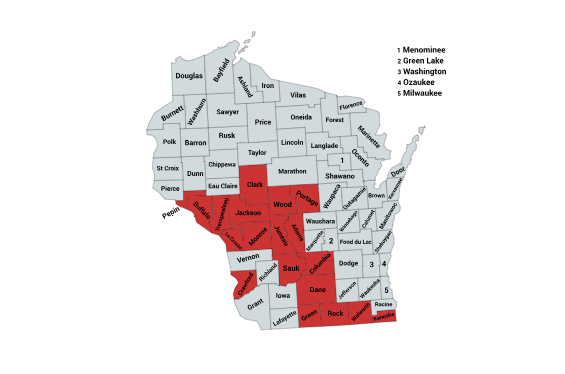
Where Do Eastern Massasauga Rattlesnakes Live in Wisconsin?
There are very few Eastern Massasauga in Wisconsin. They are listed as a state-endangered species. There have been documented sightings in the following counties.
- Kenosha
- Walworth
- Rock
- Green
- Dane
- Columbia
- Pepin
- Sauk
- Crawford
- Adams
- Juneau
- Monroe
- LaCrosse
- Buffalo
- Trempealeau
- Jackson
- Clark
- Wood
- Portage
Massasauga is actually a word in the Chippewa language. It means “great river mouth”. This possibly has reference to their choice of wet habitats. Source
They inhabit forested swampland, marshy bracken grasslands, old fields, and dry prairie.
Eastern Massasauga Rattlesnake Behavior
The Eastern Massasauga is generally thought to be docile and slow to be provoked.
They also have a reputation for being shy, timid snakes. They prefer to lie motionless in tall grass or leaf litter and let you pass by. If you approach too closely, they’ll attempt to escape to deeper cover if they’re not cornered.
This doesn’t mean they won’t bite you, though. The NIH cataloged 848 Massasauga bites in the Great Lakes region between 1800 and 2015. Source
The rattle of a massasauga is different from other rattlesnakes. It’s high-pitched and sounds more like the buzzing of a bee than a snake’s rattle.
If you come upon an eastern Massasauga too suddenly, it may bite you without rattling.
Wintertime Brumation
Snakes do not tolerate cold winters very well. They are ectotherms, which means they cannot regulate their body temperature internally. Physiologically, ectotherms cannot hibernate. Yet, they go into a state of suspended animation called brumation for up to 7 months out of the year.
Most snakes spend the winter in communal dens. Eastern Massasaugas do not. These snakes spend the winter alone or in groups of two or three. They use places such as crayfish burrows or small animal burrows as hibernacula.
Only about 70% of adults and 38% of neonate Eastern Massasaugas survive from year to year. Many of the mortalities that occur take place over the winter. Source
What Do Eastern Massasauga Rattlesnakes Eat?
An Eastern Massasauga’s primary prey is small mammals such as mice and voles. They also eat frogs, toads, and small snakes.
How Dangerous Are Eastern Massasauga Rattlesnakes?
Eastern Massasaugas are generally docile and slow-moving unless they are provoked.
The venom of the Massasauga rattlesnake is cytotoxic. Cytotoxic venom destroys body tissue. Moreover, digestive enzymes in cytotoxic venom disrupt blood flow and prevent clotting. Massasauga bites to humans are rare. However, they do occur and are potentially fatal.
There are two documented deaths in Ontario from Eastern Massasauga rattlesnake bites. In each case, the victim did not receive antivenom in time. Source

Timber Rattlesnake
| Scientific Name: | Crotalus horridus |
| Description: | Adult Timber Rattlesnakes grow between 36 and 60 inches (.91 to 1.52m) long. Their bodies are yellowish-brown with a dark chevron pattern. They also have a rusty stripe down their backs. Their tails are dark brown or black. |
| Habitat: | Timber Rattlesnakes prefer wooded areas and hillsides with rocky outcroppings. |
| Conservation status: | Listed as a species of concern and protected animal. |
Timber Rattler and Canebrake Rattlesnake are both common names for the Timber Rattlesnake. Generally, in higher-elevation habitats, they are called Timber Rattlesnakes. On the coastal plain, though, they’re called Canebrake Rattlesnakes.
The average Timber Rattlesnake grows between 36 and 60 inches (.91 to 1.52m) long. However, there have been reports of them growing up to 7 feet (2.13m) long. See
These snakes vary in color. Their general base coloration is a yellowish-brown to grey-brown, though. They have a dark brown to black chevron pattern on their back and sides against a lighter base color. This chevron pattern turns to dark bands on their dark brown or black tails. They also have a rusty to reddish stripe down their backs. Their tails are dark brown or black. There are also melanistic timber rattlers. These are dark and sometimes almost entirely black. In the dark color morph of these snakes, the tail is also darker than the rest of the snake’s body.
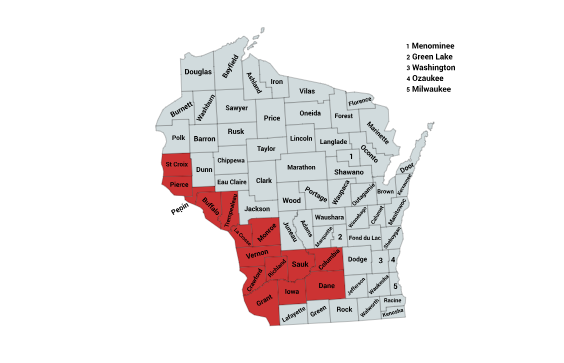
Where Do Timber Rattlesnakes Live in Wisconsin?
In Wisconsin, these snakes are listed as a species of special concern. They have been found in the following counties:
- St Croix,
- Pierce
- Pepin
- Buffalo
- Trempealeau
- Monroe
- La Crosse
- Vernon
- Crawford
- Richland
- Sauk
- Columbia
- Dane
- Iowa
- Grant
The Timber Rattlesnake lives in various habitats. These include deciduous forests, pine forests, swamps, agricultural areas, and river flood plains. These snakes are marvelous climbers and have been found in trees at heights of more than 80 feet. Source
Wintertime Brumation
Snakes do not tolerate the cold weather in the winter months very well. They are ectotherms, which means they cannot regulate their body temperature internally. Physiologically, ectotherms cannot hibernate. Yet, they go into a state of suspended animation called brumation for up to 6 months out of the year.
Timber Rattlesnakes winter underneath rocks, in hollow logs, and in rock fissures. An individual might brumate alone in some parts of their range. However, in some areas, they congregate together in a communal den with other snakes.
In hilly terrain, south-facing slopes capture more radiant warmth from the sun. So, that is where these dens are generally located. Rock ledges with deep cracks are likely denning sites.
The other snakes they den with are not necessarily just Timber Rattlesnakes. Sometimes, they share their dens with different types of snakes. You may find gray rat snakes sharing the same den with Timber rattlesnakes. These wintertime dens may hold up to 60 snakes.
What Do Timber Rattlesnakes Eat?
Timber rattlers prey on small mammals such as mice, rats, squirrels, chipmunks, and bats. They also eat small birds, other reptiles, and amphibians.
The experts have proven that timber rattlesnakes help control Lyme disease. This is because as they consume rodents, they’re also consuming ticks. A timber rattler will consume 2,500 to 4,500 ticks per year, depending on the location. See
How Dangerous Are Timber Rattlesnakes?
Timber Rattlesnakes are among the most dangerous snakes in the United States. This is due to their large size, long fangs, and high venom yield. 1% to 10% of the time, an untreated Timber Rattlesnake bite results in a fatality.
The good news is that these snakes have a relatively mild disposition. They generally give ample warning before actually striking defensively. Also, 40% to 60% of the time, they produce dry bites. In other words, although their fangs penetrate the body, they do not inject any venom. Source
These snakes produce hemotoxic venom. In other words, it destroys red blood cells. Timber Rattlesnake bites sometimes cause serious complications. These include shock, seizures, coma, internal bleeding, and deep tissue damage. Source
Rattlesnake Predators That Are Immune to Rattlesnake Venom
Although they are venomous, rattlesnakes do have some potential predators.
- One of these is the North American Racer. These snakes are immune to snake venom. They pin down their prey with their body and swallow it alive. Consequently, they are probably limited to very small rattlesnakes. North American Racers have been recorded eating rattlesnakes in the Black Hills. Source
- The non-venomous Eastern Milksnake kills by constriction. They are immune to snake venom. Consequently, they sometimes prey on Wisconsin’s rattlesnakes.
- Skunks also prey on rattlesnakes. Fortunately for them, they are also immune to snake venom.
- Badgers also eat rattlesnakes and have some immunity to rattlesnake venom.
- Feral hogs are also immune to snake venom and find rattlesnakes to be tasty snacks.
Rattlesnake Predators That Are Not Immune to Rattlesnake Venom
The following animals prey on rattlesnakes but are not immune to their venom. They have to manage to kill the snake without being bitten.
- coyotes
- bobcats
- raptors
Rattlesnake Lookalikes in Wisconsin

Bull Snakes
Bull Snakes are large, non-venomous snakes. In fact, the Bull Snake is the largest snake in Wisconsin. Individual snakes are capable of being 8 feet (2.43 M) long. People often mistake bull snakes, which are also called gopher snakes, for rattlesnakes. This is primarily because they are similarly marked. A Gopher snake can do a pretty fair rattlesnake impression when they’re agitated. They do this by coiling in a defensive posture and flattening their heads. They even vibrate their tails sometimes. The best way to differentiate between a bull snake and a rattlesnake is to observe the tail. Bull snakes don’t have a rattlesnake’s rattle. Instead, they have a pointed tail.
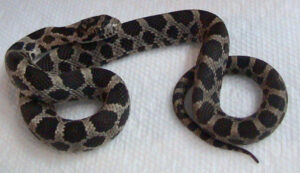
Eastern Foxsnake
Eastern Foxsnakes are large brown non-venomous snakes with blotched color patterns. They look a bit like either Eastern Copperheads or rattlesnakes.
Like Bull snakes, Eastern Foxsnakes vibrate their tails sometimes when they are agitated. If the tail is vibrating in dry leaves the effect can be quite convincing.
As with the Bull Snake, Fox Snakes have pointed tails, though. This is a defining characteristic between them and rattlesnakes.
Three other Wisconsin snakes that sometimes get confused with rattlesnakes.
- Eastern Hognose snake
- Eastern milksnake
- Northern water snake
Symptoms of Venomous Snake Bites
Some of the symptoms you may experience from a venomous snake bite include:
- Discoloration in the site of the bite.
- Swelling in the bitten area.
- Loss of muscle coordination.
- Tingling sensation in the area of the bite.
- Feeling nauseous.
- Having an abnormally rapid pulse.
What Should You Do If A Venomous Snake Bites You?
If you or someone you are with has suffered a venomous snakebite, time is of the essence. This is because the sooner a victim receives anti-venom, the less likely the venom in their body is to cause harm. In other words, it is important to seek immediate medical attention.
Do not attempt to kill the snake for identification purposes. This gives the snake a chance to bite you again. Also, consider that severed snakeheads can still bite and envenomate. If you have a phone, take a photo of the snake. Otherwise, get started on your way to the emergency room.
First Aid for Snake Bite Victims
- Remain calm and limit your movements. Do not run. If you must hike back to a vehicle, do it calmly and deliberately. Put as little stress on your heart as possible.
- Keep the area of the snake bite below the heart level and never above the heart level. Keeping the bite below the heart level will reduce the venom’s flow. However, holding the bite above your heart level will increase the venom’s flow.
- Remove all constricting items such as bracelets, watches, or rings before swelling occurs.
- Remember that using a cold compress on a venomous snake bite is not advisable. The cold may cause the local blood vessels to constrict and spread the venom faster.
- You can wash the affected area like any other wound with soap and water.
- You may cover the bite area with a moist dressing to reduce the swelling.
- Get medical help as soon as possible. Call the hospital to tell them a venomous snake has bitten you. So they can have anti-venom ready to give you when you arrive.
- A person whom a venomous snake has bitten may go into shock. If this happens, lay them flat and cover them with a blanket.
Dressing for Snake Country
- High-top leather boots and long pants are both wise ideas.
- Also, wear loose-fitting denim. If there’s a gap before the snake’s fangs touch your skin, your chances of being envenomated are lower.
- In the absence of high-top leather boots, some people wear snake gaiters.
You might also like the following:
Wild Cats in Wisconsin – Krebs Creek
Are there elk in Wisconsin – Krebs Creek
Are There Bears in Wisconsin? – Krebs Creek
Recent Posts
The only venomous snakes in Washington State are Northern Pacific Rattlesnakes. The Northern Pacific Rattlesnake (Crotalus oreganus oreganus) is a sub-species of the Western Rattlesnake. Anyone...
Skunks are not classified as true hibernators. But they go into a state of torpor when the weather gets cold. Skunks are light sleep hibernators, along with opossums, bears, and raccoons. ...

